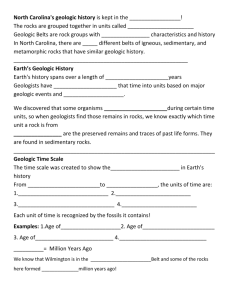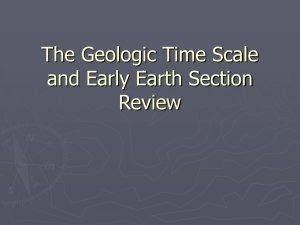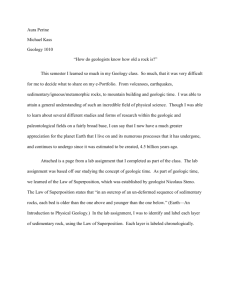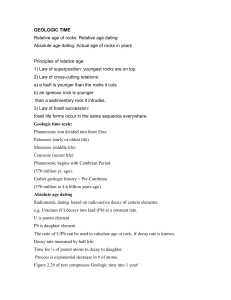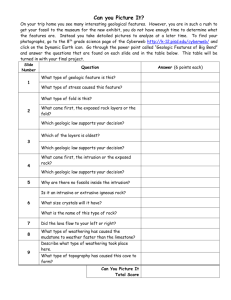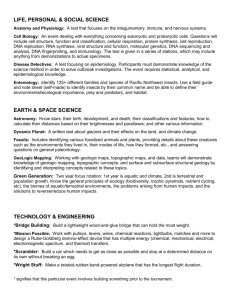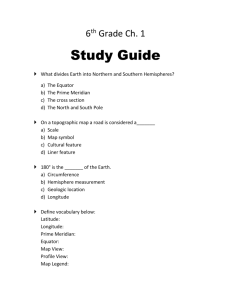Laboratory Topics
advertisement
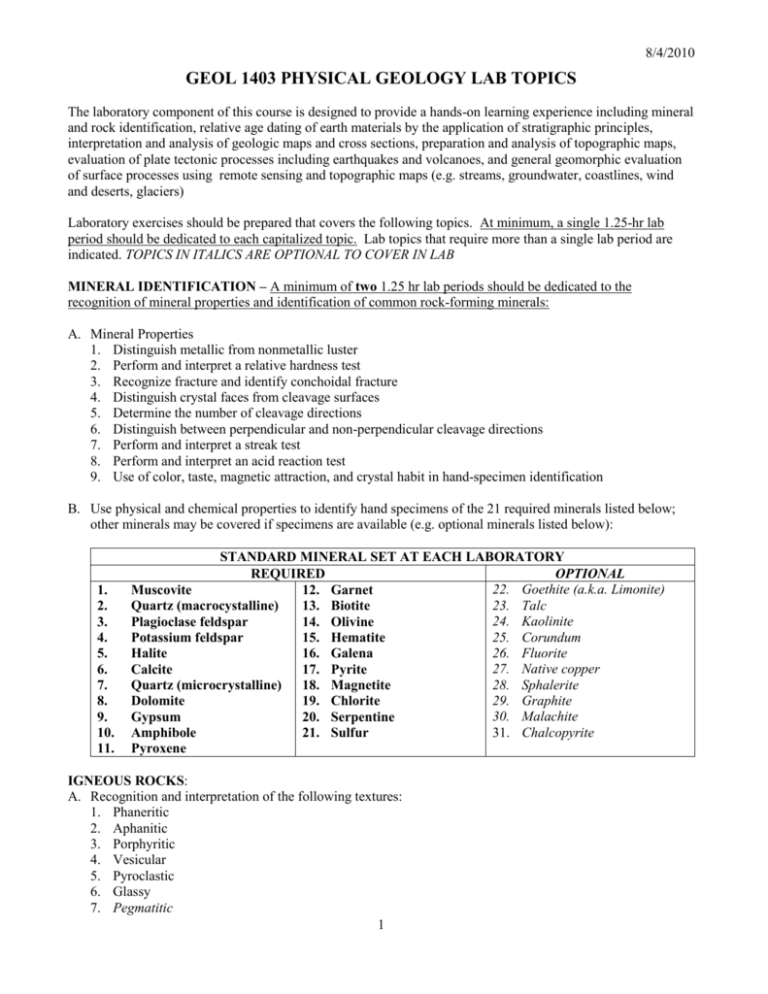
8/4/2010 GEOL 1403 PHYSICAL GEOLOGY LAB TOPICS The laboratory component of this course is designed to provide a hands-on learning experience including mineral and rock identification, relative age dating of earth materials by the application of stratigraphic principles, interpretation and analysis of geologic maps and cross sections, preparation and analysis of topographic maps, evaluation of plate tectonic processes including earthquakes and volcanoes, and general geomorphic evaluation of surface processes using remote sensing and topographic maps (e.g. streams, groundwater, coastlines, wind and deserts, glaciers) Laboratory exercises should be prepared that covers the following topics. At minimum, a single 1.25-hr lab period should be dedicated to each capitalized topic. Lab topics that require more than a single lab period are indicated. TOPICS IN ITALICS ARE OPTIONAL TO COVER IN LAB MINERAL IDENTIFICATION – A minimum of two 1.25 hr lab periods should be dedicated to the recognition of mineral properties and identification of common rock-forming minerals: A. Mineral Properties 1. Distinguish metallic from nonmetallic luster 2. Perform and interpret a relative hardness test 3. Recognize fracture and identify conchoidal fracture 4. Distinguish crystal faces from cleavage surfaces 5. Determine the number of cleavage directions 6. Distinguish between perpendicular and non-perpendicular cleavage directions 7. Perform and interpret a streak test 8. Perform and interpret an acid reaction test 9. Use of color, taste, magnetic attraction, and crystal habit in hand-specimen identification B. Use physical and chemical properties to identify hand specimens of the 21 required minerals listed below; other minerals may be covered if specimens are available (e.g. optional minerals listed below): 1. 2. 3. 4. 5. 6. 7. 8. 9. 10. 11. STANDARD MINERAL SET AT EACH LABORATORY REQUIRED OPTIONAL 22. Goethite (a.k.a. Limonite) Muscovite 12. Garnet 23. Talc Quartz (macrocystalline) 13. Biotite 24. Kaolinite Plagioclase feldspar 14. Olivine 25. Corundum Potassium feldspar 15. Hematite 26. Fluorite Halite 16. Galena 27. Native copper Calcite 17. Pyrite 28. Sphalerite Quartz (microcrystalline) 18. Magnetite 29. Graphite Dolomite 19. Chlorite 30. Malachite Gypsum 20. Serpentine 31. Chalcopyrite Amphibole 21. Sulfur Pyroxene IGNEOUS ROCKS: A. Recognition and interpretation of the following textures: 1. Phaneritic 2. Aphanitic 3. Porphyritic 4. Vesicular 5. Pyroclastic 6. Glassy 7. Pegmatitic 1 8/4/2010 B. Use of textural characteristics and composition to identify hand specimens of the 10 required rocks listed below; other rock may be covered if specimens are available: Required rocks: Andesite Basalt Diorite Gabbro Granite Obsidian Peridotite Pumice Rhyolite Tuff 1. 2. 3. 4. 5. 6. 7. Standard Igneous Rock Set in Each Laboratory Porphyritic Andesite 8. Basalt Obsidian 9. Gabbro Granite (gray) 10. Olivine Peridotite Rhyolite 11. Tuff Diorite 12. Porphyritic Basalt Pumice 13. Vesicular Basalt Porphyritic Granite 14. Volcanic Breccia SEDIMENTARY ROCKS: A. Recognition and interpretation the following textures: 1. Clastic 2. Chemical 3. Biogenic B. Use of texture and composition to identify hand specimens of the 10 required rocks listed below; other rocks may be covered if specimens are available (e.g. compositional varieties of sandstone, textural varieties of limestone, and types of sedimentary coal): Required rocks: Chert Conglomerate Dolostone Rock gypsum Limestone Rock salt Sandstone Sedimentary coal Shale Siltstone 1. 2. 3. 4. 5. 6. 7. 8. 9. Standard Sedimentary Rock Set in Each Laboratory Micrite (microcrystalline limestone) 10. Arkose Chalk 11. Fossiliferous shale Quartz sandstone 12. Rock gypsum Conglomerate 13. Dolostone Chert 14. Siltstone Shale 15. Oolitic limestone Fossiliferous limestone 16. Crystalline limestone Sedimentary coal 17. Lithic sandstone Rock salt 18. Travertine 19. Mudstone/claystone METAMORPHIC ROCKS A. Recognition and interpretation of the following textures: 1. Foliated 2. Nonfoliated (granoblastic) 3. Porphyroblastic B. Use of textures and composition to identify hand specimens of the 9 required rocks listed below; other rocks may be covered if specimens are available: 2 8/4/2010 Required rocks: Amphibolite Gneiss Marble Phyllite Quartzite Schist Serpentinite Slate Standard Metamorphic Rock Set in Each Laboratory 1. Marble (calcite) 9. Muscovite schist 2. Garnet schist 10. Amphibolite 3. Biotite schist 11. Slate 4. Quartzite 12. Gneiss (mafic) 5. Gneiss (felsic) 13. Anthracite 6. Phyllite 14. Marble (dolomite) 7. Chlorite schist 15. Metaconglomerate 8. Serpentinite MAPS IN GENERAL AND TOPOGRAPHIC MAPS – a minimum of two 1.25-hour lab periods should be dedicated to maps and topographic maps: Introduction to general features of maps and the analysis of standard USGS topographic maps: 1. Understanding the concepts of latitude and longitude 2. Reading and measuring coordinates in degrees, minutes and seconds 3. Interpretation of maps scales (graphic, ratio and verbal) 4. Identification and interpretation of common topographic map symbols 5. Understanding the principles of contour lines (isolines) 6. Application of the rules of topographic contouring 7. Construction of a topographic contour map 8. Interpretation of topographic contours (determination of land surface elevation, depression contours, contour spacing) 9. Construction of a topographic profile 10. Identification and interpretation of vertical exaggeration in cross sections GEOLOGIC TIME AND STRATIGRAPHIC RELATIONSHIPS – application of the principles of stratigraphy to determine the order of geologic events: 1. Recognition and interpretation of unconformities 2. Relative age dating of a geologic cross-section or block diagram 3. Radioactive decay and absolute age dating GEOLOGIC MAPS AND GEOLOGIC STRUCTURES – a minimum of two 1.25-hour lab periods should be dedicated to geologic maps and structures: Introduction to the fundamentals of geologic maps and use of geologic maps to identify and interpret geologic structures and stratigraphic relationships: 1. Recognition and interpretation of common geologic map symbols (e.g. geologic formations and their age, formation contact lines, faults, axis and plunge direction of folds) 2. Identification and interpretation of strike and dip symbols (horizontal, inclined and vertical attitude) 3. Recognition of fold structures in geologic maps and cross-sections (anticlines, synclines, domes & basins) 4. Recognition of faults and directions of displacement on geologic maps and cross-sections (normal, reverse & strike-slip) 5. Interpretation and completion of block diagrams 6. Interpretation of simple geologic maps and cross-sections 3 8/4/2010 PLATE TECTONICS – evaluation of plate motion and the distribution of features formed by tectonic processes, including earthquakes, volcanoes, and mantle hotspots: 1. Measurement of relative plate motion 2. Recognition and interpretation of features at convergent boundaries 3. Recognition and interpretation of features at divergent boundaries 4. Identification and interpretation of Wadati-Benioffi zones 5. Active vs. passive continental margins EARTHQUAKES: use of seismic wave data to determine the location of an earthquake epicenter, either graphically or mathematically. GENERAL GEOMORPHOLOGY – interpretation of earth surface processes, and the creation and evolution of landforms using aerial photographs, satellite images, and topographic maps; at least one 1.25-hour lab period should be dedicated to each numbered topic: 1. STREAMS Delineation of a drainage basin Calculation of a stream gradient Recognition and interpretation of superimposed stream drainage Recognition and interpretation of headward erosion / stream piracy Recognition of drainage patterns Interpretation of landform evolution dominated by stream erosion and deposition 2. GROUNDWATER Recognition and interpretation of karst topographic features Water table contouring and identification of groundwater flow direction Factors affecting infiltration and groundwater flow 3. COASTAL PROCESSES Recognition and interpretation of emergent and submergent coastlines Recognition and interpretation of coastal erosional and depositional features 4. DESERTS AND EOLIAN PROCESSES Identification of sand dune morphology, and interpretation of wind direction and sediment supply Interpretation of desert landscape evolution Recognition and interpretation of common desert landforms 5. GLACIERS Recognition and interpretation of landforms produced by valley/alpine glaciation Distinguishing between stream valleys and glacial valleys Recognition and interpretation of landforms produced by continental glaciation Measurement of the rates of glacial recession 6. MASS MOVEMENTS 4
